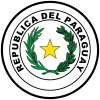Environmental issues in Paraguay
Environmental issues in Paraguay include deforestation.
Between 1990 and 2000, Paraguay had an average deforestation rate of 1%. The rate increased between 2000 and 2005 to 1.92%.[1] Paraguay also has a growing pollution problem. Many of the country’s rivers suffer from toxic dumping. Tanneries are particularly harmful, releasing mercury and chromium into rivers and streams. Runoff from toxic chemicals used by farmers also seeps into Paraguay’s waters. In the Chaco, the salination of already arid land makes farming even more difficult. Furthermore, poachers have almost free rein in Paraguay, and continue to foster the illegal trade in armadillo, deer and crocodile skins.
References
| This image is available from the United States Library of Congress Prints and Photographs Division under the digital ID {{{id}}} This tag does not indicate the copyright status of the attached work. A normal copyright tag is still required. See Wikipedia:Copyrights for more information. |

